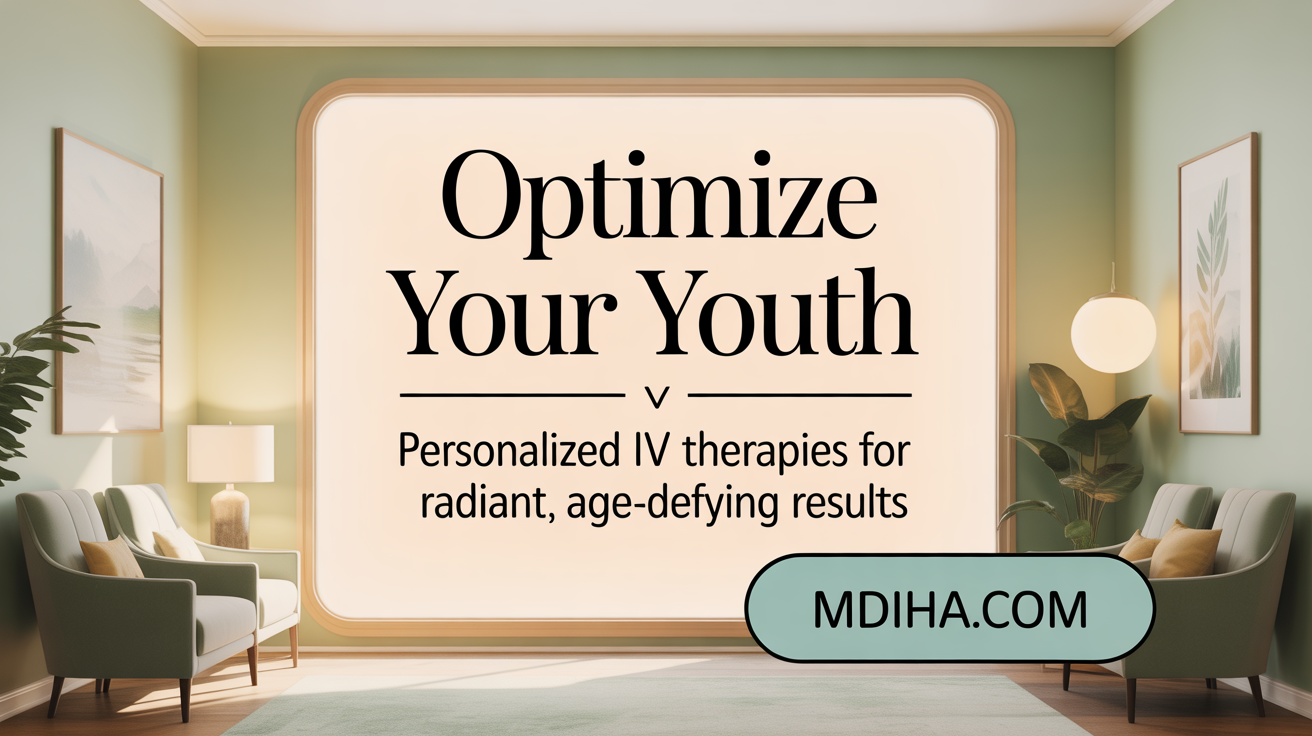Introduction to Personalized Longevity Therapies
As the science of longevity advances, regenerative medicine and intravenous (IV) therapies emerge as transformative tools to extend healthspan and combat aging at its roots. This article explores how these treatments can be tailored to individual health needs, blending cutting-edge science with personalized care strategies to maximize vitality, support tissue regeneration, and slow cellular aging processes.
Understanding the Cornerstones of Regenerative Medicine

What are the main types of regenerative therapies?
Regenerative medicine employs a variety of innovative treatments aimed at stimulating the body’s natural ability to heal itself. Some of the most common therapies include stem cell therapy, platelet-rich plasma (PRP) injections, prolotherapy, and scaffold fabrication.
Stem cell therapy involves the use of mesenchymal stem cells, which are sourced from locations like bone marrow, adipose tissue, and umbilical cord blood. These cells have the capacity to develop into various tissue types, making them ideal for regenerating cartilage, bone, and even nervous tissue.
Platelet-rich plasma (PRP) therapy utilizes concentrated blood components to enhance healing. Blood drawn from the patient is spun to extract platelets rich in growth factors, which are then injected into injured tissues to stimulate repair and reduce inflammation.
Prolotherapy, often used for musculoskeletal pain, involves injecting a solution—commonly hypertonic dextrose—into damaged tissues. This irritant prompts the body to initiate a healing response, promoting tissue growth and strengthening.
Another significant approach is scaffold fabrication, which uses biomaterials to create structures that support cell growth and tissue development, often in conjunction with stem cells and growth factors.
More advanced treatments include bioengineering and 3D bioprinting, which enable the creation of complex tissues for transplantation and repair.
Scientific mechanisms behind tissue repair
The therapies work primarily through a few interconnected biological mechanisms. Stem cells differentiate into needed cell types, replacing damaged or degenerated tissue. Growth factors released from platelets or delivered via other means stimulate cellular proliferation and repair.
Scaffolds provide a supportive matrix that mimics natural tissue, guiding the organization of new tissue growth. Additionally, these treatments activate dormant stem cells in the body, enhancing the healing process.
All these methods aim to address the root causes of tissue degeneration, such as inflammation and cellular damage, promoting long-term recovery rather than just symptomatic relief.
By integrating these advanced techniques, regenerative medicine is revolutionizing treatments for joint health, injury recovery, aging, and chronic diseases, moving toward more natural, less invasive solutions with sustained benefits.
Showcasing Regenerative Medicine Approaches and Their Clinical Applications

What are some common examples of regenerative medicine approaches?
Regenerative medicine encompasses a variety of innovative techniques aimed at repairing or replacing damaged tissues and organs. One common approach involves injecting stem cells or progenitor cells, which are often sourced from the patient's own body or from donors, and then directed to differentiate into specific cell types to accelerate healing. These stem cell therapies can be used in conditions like joint degradation and neurological diseases.
Another method utilizes biologically active molecules such as growth factors, which can be administered directly or secreted by infused cells. These molecules stimulate the body's natural repair mechanisms, reduce inflammation, and promote tissue regeneration.
Tissue engineering also plays a significant role, where lab-grown organs and tissues are created in vitro and transplanted into patients. This includes scaffolds fabricated from biocompatible materials that support cell growth and tissue development.
In dental regeneration, stem cells are utilized to repair or grow new teeth, providing solutions for dental tissue damage. Similarly, extracellular matrix materials are used in reconstructive surgeries to support tissue structure and healing.
How are regenerative therapies used in conditions like osteoarthritis and heart disease?
In joint health, particularly osteoarthritis, regenerative treatments aim to restore cartilage and repair severely degraded tissues. Techniques like platelet-rich plasma (PRP) therapy, stem cell injections, and prolotherapy help rebuild joint tissues, reduce pain, and improve mobility.
In cardiovascular health, regenerative medicine leverages growth factors and stem cells to repair damaged heart tissue resulting from heart attacks or chronic conditions. These therapies promote the formation of new blood vessels and help regenerate cardiac tissue, aiming to improve heart function and prevent further deterioration.
What advances are being made in tissue engineering and bioengineering?
Recent breakthroughs include developments in 3D bioprinting and scaffold fabrication, which allow scientists to create complex, functional tissues that closely mimic natural ones. These technological improvements facilitate the creation of more sophisticated organs for transplantation and long-term repair.
Progress in bioengineering involves designing scaffolds that provide optimal environments for cell growth and differentiation, as well as integrating gene editing and regenerative drug delivery systems. Together, these advancements are paving the way for extending healthspan, supporting longevity, and reducing age-related degenerative conditions.
| Technique | Application | Purpose | Additional Details |
|---|---|---|---|
| Stem Cell Therapy | Joint, Cardiac, Neural | Tissue regeneration, reducing inflammation | Uses stem cells from various sources, including adipose tissue, umbilical cord |
| Scaffold Fabrication | Organ and tissue engineering | Provide support for cell growth | Biocompatible, customizable to patient needs |
| Growth Factor Therapy | Wound healing, tissue repair | Stimulate natural regenerative processes | Often combined with cell therapies |
| 3D Bioprinting | Complex tissue creation | Develop organs for transplantation | Supports personalized medicine |
By integrating these approaches, regenerative medicine continues to evolve, offering hope for more effective, less invasive, and personalized treatments that enhance health and longevity.
Tailoring IV Therapy for Longevity and Anti-Aging Benefits

What is a longevity IV drip and how does it support anti-aging?
A longevity IV drip is a specially formulated infusion that delivers a powerful mix of antioxidants, vitamins, minerals, and amino acids directly into the bloodstream. This targeted delivery ensures rapid absorption and maximum effectiveness in supporting cellular health. These customized therapies are designed to combat the effects of aging by neutralizing free radicals, reducing oxidative stress, and stimulating cellular repair processes. At clinics like Nimativ Wellness, licensed healthcare professionals oversee personalized IV regimens based on current scientific evidence. The primary goal is to enhance overall vitality, strengthen immune responses, increase energy levels, and promote tissue rejuvenation. While the formulations vary, they are all built to optimize the body’s natural capacity to maintain youthful function.
How does IV therapy help reverse or slow down aging?
IV therapy works by delivering high doses of essential nutrients and antioxidants directly into the bloodstream, ensuring quick and maximal absorption. This method provides a potent approach to slowing aging-related changes. For example, NAD+ (Nicotinamide Adenine Dinucleotide) supports the activation of longevity-related genes called sirtuins, which are involved in cellular repair, neuroprotection, and metabolic health.
Antioxidants such as Glutathione and Alpha-Lipoic Acid are included to neutralize harmful oxidative molecules, reduce inflammation, and protect cells from damage. Additionally, vitamins like C, B-12, and Biotin contribute to healthier skin, stronger immune defenses, and better metabolic efficiency.
By improving cellular energy production, reducing the biological markers of aging, and enhancing tissue regeneration, IV therapy supports a more youthful appearance and improved physical performance. It’s a promising adjunct to comprehensive anti-aging programs, helping to slow down the visible and microscopic signs of aging.
Stem Cell Therapy: Personalized Approaches for Cellular Regeneration and Longevity
What are the sources and types of stem cells used in regenerative therapies?
Stem cell therapy utilizes various sources of stem cells, including autologous cells from the patient’s own body, allogeneic cells from donors such as umbilical cord tissue or blood, and induced pluripotent stem cells (iPSCs). These cells can transform into different specialized tissues and are selected based on the specific health condition and treatment goals.
How do stem cells work in tissue repair and inflammation reduction?
Stem cells promote healing by activating dormant regenerative processes. They release growth factors that stimulate tissue regeneration, reduce inflammation, and encourage new blood vessel formation. For example, stem cell IV infusions deliver these cells directly into the bloodstream, where they seek out damaged tissues and assist in their repair.
In which conditions are stem cell therapies most commonly applied?
Stem cell treatments are used for a wide range of age-related and chronic conditions. These include neurodegenerative diseases, autoimmune disorders such as rheumatoid arthritis, cardiovascular injuries like heart tissue damage, orthopedic issues like joint degeneration, and for enhancing wound healing. The therapy aims to regenerate damaged tissues, alleviate pain, and improve overall function.
What are the typical treatment protocols and safety standards?
Most stem cell therapies involve comprehensive diagnostics, personalized cell preparation, and infusion or localized injection procedures. Treatments are performed under strict standards, including cGMP (current Good Manufacturing Practice) and ISO certifications, ensuring safety and efficacy.
How does personalized medicine enhance stem cell therapy?
Each treatment plan is tailored to the individual’s unique health profile and goals. Combining stem cell therapy with supportive interventions like hormonal optimization, nutritional strategies, and advanced diagnostics maximizes outcomes and minimizes risks.
| Aspect | Details | Additional Notes |
|---|---|---|
| Main sources | Autologous, allogeneic, iPSCs | Derived from patient, donors, or lab-inducing pluripotency |
| Application areas | Joint health, neurological, cardiovascular, skin, autoimmune | Conditions related to aging and tissue damage |
| Safety standards | cGMP, ISO, clinical studies | Ensuring quality, safety, and regulatory compliance |
| Treatment format | IV infusions, local injections | Minimally invasive, office-based procedures |
| Personalization | Based on diagnostics and health goals | Custom therapies increase effectiveness |
Regenerative medicine continues to evolve, integrating personalized stem cell approaches with advanced diagnostics and safety standards to support healthy aging and tissue rejuvenation.
Integrating Regenerative and Longevity Therapies into Holistic Health Plans
Combining regenerative medicine with functional and holistic approaches
Integrating regenerative therapies into a comprehensive health plan means not just focusing on tissue repair but also addressing underlying health factors. Combining regenerative medicine with functional and holistic medicine can enhance healing by considering lifestyle, diet, stress levels, and environmental influences. This integrated approach supports the body’s natural processes, promoting overall wellness and sustainable health improvements.
The role of lifestyle, nutrition, and stress management
Lifestyle factors are critical to the success of regenerative treatments. Proper nutrition provides the building blocks for cell repair and regeneration. Stress management techniques, such as mindfulness and physical activity, reduce inflammation and support recovery. By optimizing lifestyle choices, individuals can improve their regenerative outcomes, maintain health gains longer, and enjoy better quality of life.
Importance of personalized diagnostics like genomic and metabolic testing
Personalized diagnostics, including genomic and metabolic testing, are essential for creating tailored health strategies. Genetic testing can reveal predispositions to certain aging-related conditions, while metabolic assessments determine how well the body uses nutrients and energy. These insights help health practitioners develop precise treatment plans that target individual needs, maximizing the effectiveness of regenerative and longevity therapies.
Strategies for extending healthspan
To extend healthspan—the period of life spent in good health—personalized longevity plans combine regenerative treatments, advanced diagnostics, and lifestyle modifications. Regular wellness screenings, hormone optimization, and nutritional adjustments support cellular vitality. Active management of inflammation and oxidative stress, along with functional medicine interventions, helps slow down aging processes, enabling people to enjoy more active and independent lives for years to come.
Advancements and Innovations Shaping the Future of Regenerative Longevity Treatments

How are tissue engineering, bioprinting, and scaffold fabrication advancing regenerative medicine?
Recent breakthroughs in tissue engineering and bioprinting are revolutionizing the way we create complex tissues and organs. Using scaffolds made from biocompatible materials, scientists can now cultivate tissues in the lab that mimic natural structures. These advances support not only organ repair but also longevity by promoting healthy tissue regeneration.
What role do gene therapies and targeted techniques play?
Gene therapy technologies are allowing precise modification of cells to enhance their regenerative capacity. Advanced targeting methods, including gene editing tools like CRISPR, enable scientists to direct treatments specifically to damaged tissues, minimizing side effects and improving outcomes.
How are research discoveries translating into clinical applications?
The journey from laboratory research to practical therapies involves rigorous clinical trials. Many innovative regenerative approaches—such as stem cell therapies combined with bioengineering—are now moving into clinical settings, offering more effective and personalized options for extending health span.
What emerging trends are shaping personalized medicine?
Personalized regenerative medicine leverages diagnostic tools like genomic testing and metabolic assessments to tailor treatments. This approach ensures therapies address individual health challenges, optimizing recovery and aging processes according to each person’s unique biological profile.
| Technology Aspect | Focus Area | Impact on Longevity | Additional Details |
|---|---|---|---|
| Tissue Engineering | Lab-grown tissues, Organs | Supports repair and regeneration | Using scaffolds, stem cells, and growth factors |
| Bioprinting | 3D tissue printing | Enables complex tissue reconstruction | High precision, customizable tissue constructs |
| Gene Therapy & Targeting | Genetic modifications, CRISPR | Enhances cellular function, repair | Directs therapies precisely to damaged tissues |
| Personalized Medicine | Genomic and metabolic testing | Customizes treatments, reduces risks | Tailors approaches to individual needs |
Staying at the forefront of these technological advances promises a future where aging challenges are addressed more effectively, supporting longer, healthier lives.
The Patient-Centered Approach: Personalized Longevity Medicine in Practice
Importance of individualized treatment plans
Personalized longevity medicine emphasizes tailoring treatments to each person's unique health profile. Instead of one-size-fits-all solutions, clinics develop customized plans based on genetic, metabolic, and lifestyle assessments. This approach ensures that therapies address specific health challenges and goals, leading to more effective and safer outcomes.
Diagnostic tools such as PNOE metabolic assessments and InBody analysis
Advanced diagnostics play a vital role in crafting personalized strategies. The PNOE analyzer provides insights into metabolic efficiency, VO2 max, and fat-burning capacity, helping clinicians understand how well the body uses energy. InBody analysis offers detailed body composition data, tracking muscle mass, fat levels, and hydration. These tools guide targeted interventions to optimize vitality and slow aging.
Role of the concierge and specialized clinic experiences
Luxury, patient-centered clinics often offer a concierge-style experience, ensuring comfort, privacy, and personalized service. Experts work closely with each patient, performing thorough exams and diagnostics. This dedicated attention fosters trust and engagement, which are essential for successful longevity programs.
Goals of longevity medicine focusing on vitality and quality of life
Ultimate aims include extending health span—additional years of vibrant living—and maintaining independence. Treatments focus on boosting energy, improving mobility, and reducing age-related decline. By addressing root causes like inflammation, hormonal imbalance, and cellular aging, longevity medicine strives to improve daily well-being and long-term health, enabling individuals to live life to the fullest.
Optimizing Your Longevity Journey with Customized Therapeutics
Personalized IV and regenerative therapies represent a paradigm shift in longevity medicine, offering scientifically grounded, minimally invasive strategies to repair, rejuvenate, and protect cellular and tissue health. By integrating advanced diagnostics, targeted treatments, and holistic care principles, individuals can craft bespoke longevity plans that address their unique health profiles and aging challenges. This tailored approach not only helps slow biological aging but also enhances quality of life and functional independence, ultimately supporting decades of vibrant, healthy living.
References
- 10 Ways Regenerative Medicine Can Enhance Your Longevity and ...
- Why Regenerative Medicine Is Right for You - The Longevity Center
- Stem Cell IV Therapy - A Comprehensive Guide (2025)
- Cell Regenerative Therapy & Longevity Medicine Downers Grove, IL
- Why Longevity Medicine is the Future of Wellness
- IV Therapy Milan Regenerative | Image
- Longevity Therapy | Wellness Clinic | Texas - HEALR Health
